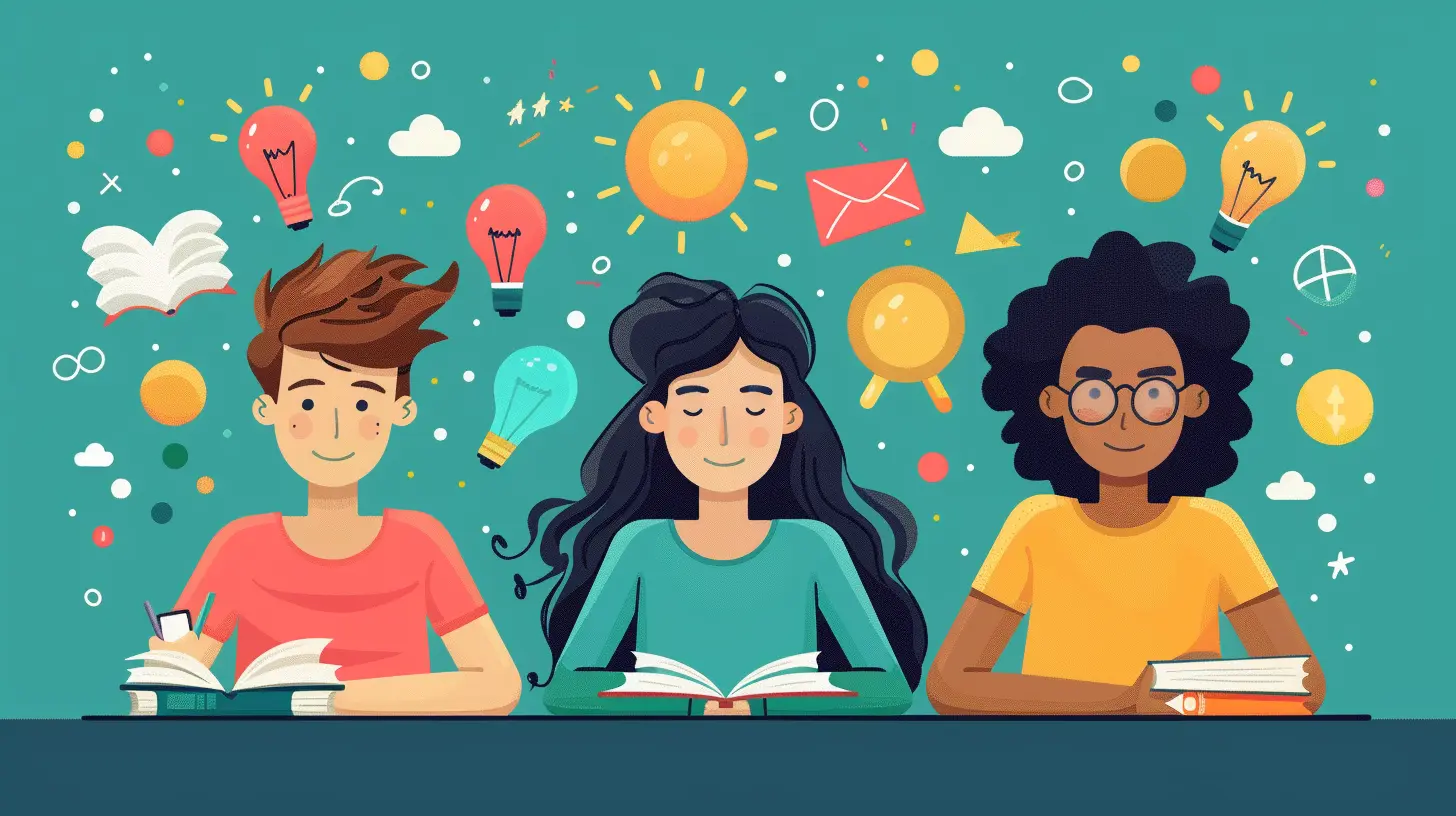How to Use Learning Styles to Reduce Student Stress
4 July 2025
Let’s be honest—being a student these days can feel like juggling flaming swords while riding a unicycle. Between classes, assignments, exams, and extracurriculars, stress can creep in fast. And when you throw one-size-fits-all learning methods into the mix, it only gets worse.
But what if I told you there's a way to make learning less overwhelming and more natural? That’s where learning styles step in like a breath of fresh air. When students understand how they learn best, they can stop fighting against the current and start flowing with it. And guess what? That shift can melt away a lot of the stress that keeps students up at night.
So, grab a coffee (or your favorite brain fuel), and let’s chat about how tapping into learning styles can genuinely make the student experience a whole lot smoother—and saner.
What Are Learning Styles, Anyway?
Before we dive into stress reduction, let’s clear up what we mean by “learning styles.” Simply put, learning styles refer to the preferred way individuals absorb, process, and retain information.Everyone processes the world a little differently—some of us need to hear something out loud, others need to see it, and some need to physically do it to make it stick.
The most common learning styles are:
- Visual: Learning through seeing
- Auditory: Learning through hearing
- Kinesthetic: Learning through doing or movement
- Reading/Writing: Learning best by reading and taking notes
Most people are a mix, but usually one style shines through more than the others. Knowing which one you tend to lean toward? That’s your secret weapon.
Why Is Student Stress Such a Big Deal?
Stress isn't just an annoying feeling—it messes with everything. Here’s what it can do:- Cloud concentration
- Lower academic performance
- Hamper sleep and energy
- Fuel anxiety and depression
- Kill motivation
When students don’t understand how they learn best, they often end up using methods that don’t work for them. Imagine trying to read a novel in a language you barely understand—it’s exhausting, frustrating, and totally ineffective.
But when students match their learning style with their study habits, everything starts falling into place. The brain says “Thanks!” and stress levels begin to drop.
Matching Learning Styles to Study Habits
Each learning style comes with its own toolkit. Let’s break down how students can tailor their study habits to fit their learning style—and leave stress behind.1. Visual Learners: Paint the Picture
How They Learn:
Visual learners take in info best through images, charts, graphs, and diagrams. If you find yourself doodling in the margins or zoning out during long lectures, you might be in this camp.Stress-Reducing Strategies:
- Use color-coded notes or highlighters- Convert notes into mind maps or flowcharts
- Watch videos or animations on difficult topics
- Organize notes in visual formats—like bullet points with icons
Visual learners should stay away from endless blocks of text. Instead, make information visible and meaningful.
> Think of it like a comic strip—you remember visuals better than long walls of dialogue, right?
2. Auditory Learners: Tune In
How They Learn:
Auditory learners thrive on sound. They remember details from discussions, lectures, or audiobooks more than just reading.Stress-Reducing Strategies:
- Record lectures to replay later- Read out loud to yourself (yes, even if it feels goofy)
- Join or create study groups for discussion
- Use rhymes, songs, or verbal repetition
Trying to force-feed textbooks to an auditory learner is like trying to charge a phone with the wrong cable. It just doesn’t work—and it creates anxiety.
> Ever get a song stuck in your head? That’s the magic of audio—it sticks with you.
3. Kinesthetic Learners: Hands-On and Moving
How They Learn:
Kinesthetic learners are all about doing. They need movement, touch, and real-world interaction to grasp concepts.Stress-Reducing Strategies:
- Use flashcards and physically move them around- Build models or act out scenarios
- Walk around while reviewing notes
- Take frequent breaks to move between study sessions
Sitting still for hours? Torture. But integrating movement makes learning feel like second nature.
> Picture it like riding a bike—you learn by getting on and pedaling, not reading about it.
4. Reading/Writing Learners: Just Give Them a Notebook
How They Learn:
These learners have a love affair with words. They thrive through reading and writing—textbooks, essays, notes, you name it.Stress-Reducing Strategies:
- Take detailed notes during lectures (then rewrite or summarize them)- Turn complex ideas into written explanations
- Use old-school textbooks over flashy videos
- Create flashcards with written definitions
When these learners get their hands on a solid outline or a well-written article, they’re in their element. Information soaks in like water into a sponge.
> You know you're this type if you've ever written out a concept five different ways until it finally clicks.
Bonus: Mixing It Up (Because No One Is 100% One Style)
Here’s the truth: most people are a mix of styles. Relying on just one can limit growth, so a blended approach often works best. If you're mainly a visual learner, sprinkle in some auditory or kinesthetic elements. It keeps things fresh and helps make connections in different ways.Also, switching styles can help when stress hits hard. If reading stops making sense one day, try explaining the concept out loud or drawing it. It’s like having multiple tools in your belt—and using the right one at the right moment.
How Teachers Can Help (Yes, You!)
We’ve talked a lot about what students can do, but teachers play a huge role too. When educators recognize and support different learning styles, they help students succeed—not just academically, but emotionally.Here’s how teachers can lighten the load:
- Offer content in multiple formats (videos, readings, hands-on activities)- Encourage students to explore their learning preferences
- Create flexible assignments that allow choice in how work is completed
- Promote group work and peer teaching to bring in diversity of style
Even small adjustments—like using visuals in a lecture or breaking up long talking segments with activities—can make a world of difference.
As a teacher, you’re not just delivering content—you’re guiding students through their unique learning journey. And that support? It's worth more than gold when it comes to reducing stress.
Testing Isn’t One-Size-Fits-All Either
We can’t talk about school stress without mentioning the big T: Tests. Standardized tests, pop quizzes, final exams—they often favor one kind of learner over another (usually reading/writing).But assessments don’t have to be soul-crushing.
> What if we judged a fish by its ability to climb a tree? That’s what it feels like for some students when tests don’t match their learning style.
Alternative assessments—like presentations, visual projects, or oral exams—give students the chance to shine in a way that works for them. It’s not about going easy—it’s about leveling the playing field.
Mental Health Matters: Reduce Stress, Boost Confidence
When learning aligns with style, you’re not just making education easier—you’re protecting mental health. Students who understand and trust their learning process:- Feel more in control
- Build confidence
- Stay motivated
- Experience less procrastination
- Improve focus and memory
Less stress doesn’t mean less learning—it usually means better learning. And that boost in well-being affects everything from friendships to future goals.
Starting the Journey: How to Identify Learning Styles
Still not sure what your learning style is? No worries—you’re not alone. Here are a few ways to figure it out:- Take a learning style quiz (tons of free ones online)
- Reflect on your past successes—what study methods worked?
- Try different study techniques and track which feel best
- Ask teachers or peers what they’ve observed about your learning habits
Self-awareness is step one. From there, everything starts to click.
Final Thoughts: Work Smarter, Not Harder
School was never meant to feel like a never-ending uphill battle. The truth is, when students study in a way that feels natural, learning becomes more efficient—and way less stressful. It's not about being lazy or cutting corners. It’s about working smarter, not just harder.Learning styles are the compass that guide you through the academic storm. When students and educators embrace them, they unlock a powerful tool for academic success and emotional balance.
So whether you’re a student feeling overwhelmed or a teacher ready to make a change, remember: you're not broken. You just need to meet your brain where it’s at.
And honestly? That small shift can change everything.
all images in this post were generated using AI tools
Category:
Learning StylesAuthor:

Olivia Lewis
Discussion
rate this article
2 comments
Camille Bowers
Fascinating approach! I'm intrigued by the concept of tailoring learning styles to alleviate stress. How can we effectively integrate this into classroom practices?
November 25, 2025 at 5:54 AM

Olivia Lewis
Thank you! To integrate this approach into classroom practices, consider conducting assessments to identify students' learning styles and then customize activities accordingly. Incorporating varied teaching methods—like visual aids, hands-on projects, and collaborative discussions—can help meet diverse needs and reduce stress.
Wren McFarlane
Empowering students through understanding their unique learning styles is a transformative approach! By embracing diverse methods, educators can reduce stress and enhance engagement, creating an inclusive environment where every learner thrives. Let's champion these strategies for a brighter and more confident future in education!
July 20, 2025 at 4:33 AM

Olivia Lewis
Thank you for your insightful comment! Embracing diverse learning styles truly fosters an inclusive environment, empowering students and reducing stress. Let's continue championing these transformative strategies!


